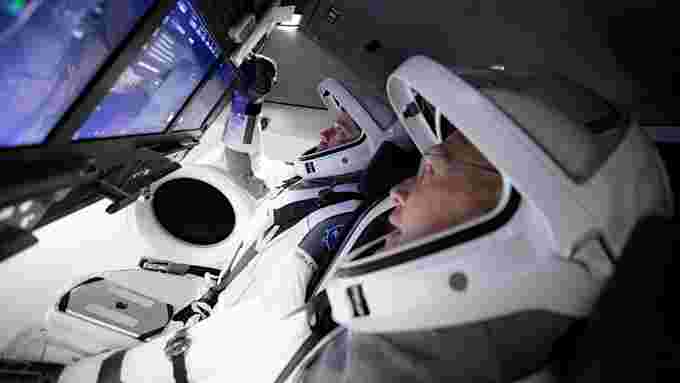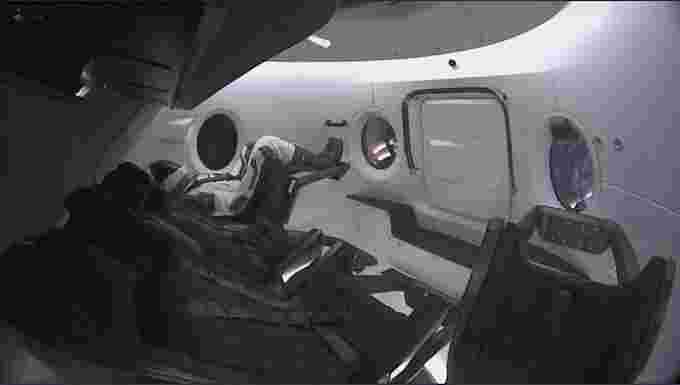NASA and SpaceX are about to make history.
SpaceX's Crew Dragon spacecraft currently sits perched atop a Falcon 9 booster rocket at Kennedy Space Center's historic Launch Complex 39A. There, it awaits the arrival of NASA astronauts Bob Behnken and Doug Hurley, who will board and strap in on Wednesday afternoon for the Demo-2 flight mission, which will carry the pair into orbit to rendezvous with the International Space Station.
This Demo-2 mission will be history-making in two ways. First, this will be the first-ever commercial launch to carry astronauts to the International Space Station, and second, it will be the first crewed launch from American soil since the Space Shuttle program ended nearly a decade ago.
"We are so proud and happy for Doug and Bob," astronaut Nicole Mann, who is slated to fly on a future commercial launch on Boeing's Starliner spacecraft, said in a NASA statement. "It feels kind of like one of your close family members having a great lifetime achievement — and really, that's what it is."
The instantaneous launch window for this important mission is scheduled to reach 'T-minus zero' at 4:33 p.m. EDT on Wednesday, May 27, 2020. The public can tune in to watch this event live online via NASA TV, starting at 12:15 p.m. EDT.
If all goes as planned, the Falcon 9 booster will complete the journey to orbit, carrying Behnken and Hurley on board the Crew Dragon, in just under 9 minutes. They will then be on-route for a rendezvous with the International Space Station at 11:39 a.m. EDT on Thursday, May 28.
By the time the pair of astronauts gets to experience the weightlessness of being in orbit, the 1st stage of the Falcon 9 rocket will already be moments away from setting down on the droneship "Of Course I Still Love You", out on the Atlantic Ocean.
 SpaceX's flight profile for the Demo-2 mission. The Crew Dragon is expected to reach orbit in just 8 minutes and 47 seconds after liftoff, while the Falcon 8 1st stage is scheduled to touch down at 9 minutes, 22 seconds after launch. Credit: NASA TV
SpaceX's flight profile for the Demo-2 mission. The Crew Dragon is expected to reach orbit in just 8 minutes and 47 seconds after liftoff, while the Falcon 8 1st stage is scheduled to touch down at 9 minutes, 22 seconds after launch. Credit: NASA TV
A mission's 'launch window' is the time set by ground controllers where a rocket can lift off and be in the best position to deploy a satellite properly, or for a spacecraft to rendezvous with the International Space Station. Once a launch window opens, often there is a certain amount of time where a rocket can delay and still accomplish its mission. Other missions, such as Demo-2, have an 'instantaneous launch window'. This means that the rocket must lift off at the exact moment the timer reaches T-zero. Otherwise, the launch must be aborted for that day and delayed until the next launch window opens.
If Demo-2 cannot lift off on Wednesday at 4:33 p.m. EDT, either due to some technical issue or due to unsafe weather conditions, NASA and SpaceX have set alternative launch windows for 3:22 p.m. EDT on Saturday, May 30, and 3 p.m. EDT on Sunday, May 31.
 SpaceX Demo-1 performed flawlessly on launch and arrival to the International Space Station back on March 2, 2019. Credit: NASA TV
SpaceX Demo-1 performed flawlessly on launch and arrival to the International Space Station back on March 2, 2019. Credit: NASA TV
NASA says the latest weather forecast from the U.S. Air Force's 45th Weather Squadron gives a 60 per cent chance of favourable conditions for the Demo-2 launch. The primary weather concerns forecasters noted for the launch are the potential for spacecraft to fly through precipitation, cumulonimbus storm clouds, or cumulus clouds- Any of which could be troublesome for a space launch.
Read: Lightning strikes almost doomed the 1969 Apollo 12 Moon mission
NEXT-GEN SPACEFLIGHT
Past spacecraft that have carried astronauts into orbit were marvels of technology. SpaceX's Crew Dragon, on the other hand, looks to be something straight out of science fiction that has been made real.
 NASA astronauts Doug Hurley (foreground) and Bob Behnken sit in the Crew Dragon capsule, which is equipped with touch-screen controls. Credit: NASA
NASA astronauts Doug Hurley (foreground) and Bob Behnken sit in the Crew Dragon capsule, which is equipped with touch-screen controls. Credit: NASA
Although the two astronauts appear to be cramped in the above photograph, the Crew Dragon is surprisingly roomy when compared to older spacecraft. Even the current Soyuz capsules are very cramped, with little room for the astronauts and cosmonauts to move around during a launch.
 SpaceX's "anthropomorphic test device" or ATD, named "Ripley", made the trip to the ISS during the uncrewed Demo-1 mission. It was certainly not crowded on this flight. Credit: NASA TV
SpaceX's "anthropomorphic test device" or ATD, named "Ripley", made the trip to the ISS during the uncrewed Demo-1 mission. It was certainly not crowded on this flight. Credit: NASA TV
According to NASA: * "As the final flight test for SpaceX, this mission will validate the company's crew transportation system, including the launch pad, rocket, spacecraft, and operational capabilities. This also will be the first time NASA astronauts will test the spacecraft systems in orbit."*
Sources: NASA | SpaceX | 45th Weather Squadron
RELATED: SPACEX'S ROCKET EXPLODES DURING CRITICAL TEST
https://news.google.com/__i/rss/rd/articles/CBMicWh0dHBzOi8vd3d3LnRoZXdlYXRoZXJuZXR3b3JrLmNvbS9jYS9uZXdzL2FydGljbGUvbmFzYS1zcGFjZXgtZmlyc3QtY3Jld2VkLWxhdW5jaC1mcm9tLWFtZXJpY2EtaW4tbmVhcmx5LWEtZGVjYWRl0gEA?oc=5
2020-05-26 20:10:00Z
52780800879773
Tidak ada komentar:
Posting Komentar